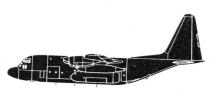
ASN Wikibase Occurrence # 320309
| Date: | Tuesday 21 April 2015 |
| Time: | 12:18 |
| Type: |  Lockheed AC-130J Ghostrider |
| Owner/operator: | United States Air Force - USAF |
| Registration: | 09-5710 |
| MSN: | 5710 |
| Year of manufacture: | 2012 |
| Fatalities: | Fatalities: 0 / Occupants: 8 |
| Aircraft damage: | Substantial, written off |
| Category: | Accident |
| Location: | 76 km S of Valparaiso-Eglin AFB, FL (VPS) -
 United States of America United States of America
|
| Phase: | Manoeuvring (airshow, firefighting, ag.ops.) |
| Nature: | Military |
| Departure airport: | Valparaiso-Eglin AFB, FL (VPS/KVPS) |
| Valparaiso-Eglin AFB, FL (VPS/KVPS) | |
| Investigating agency: | USAF AIB |
| Confidence Rating: |
The Lockheed AC-130J Ghostrider, assigned to the USAF's 413th Flight Test Squadron, 96th Test Wing, departed controlled flight over water to the south of Eglin AFB and then was recovered and landed safely. There were no significant injuries to the crew. Post-flight engineering analysis revealed that the mishap aircraft exceeded the Design Limit Load (DLL), thus rendering it unsafe for further flight.
The mishap occurred on a medium risk flying qualities test sortie out to the edges of the flight envelope. The pilot was attempting to execute a Steady Heading Sideslip (SHSS) to the RUDDER Special Alert of the Advisory Caution and Warning System (ACAWS). This is normally a prohibited maneuver, but the Director of Operations at Air Force Materiel Command (AFMC/A3) signed a waiver approving the test team to fly to this limit. The MA exceeded 14.5° Angle of Sideslip (AoS), triggering the RUDDER Special Alert and continued increasing AoS until it departed controlled flight, eventually tumbling to an inverted position. Shortly thereafter, the aircraft recovered from the departure and the copilot took the controls to recover from the near vertical dive. In the process of the departure and recovery, the aircraft lost approximately 5,000 feet of altitude, experienced 3.19 times the normal force acceleration (Gs), and over sped the flaps by over 100 knots. The over G exceeded the aircraft's Design Limit Load.
The Accident Investigation Board (AIB) President found, by a preponderance of the evidence, the cause of this mishap was the MP's [Mishap Pilot's] excessive rudder input during the test point followed by inadequate rudder input to initiate a timely recovery from high AoS due to Overcontrolled/Undercontrolled Aircraft and Wrong Choice of Action During an Operation.
Additionally, the AIB President found, by a preponderance of the evidence, the following factors substantially contributed to the mishap: Instrumentation and Warning System Issues, Spatial Disorientation, Confusion, and the fact the test team was Provided Inadequate Procedural Guidance or Publications.
Accident investigation:
 |
|
Sources:
Revision history:
| Date/time | Contributor | Updates |
|---|
The Aviation Safety Network is an exclusive service provided by:


 ©2024 Flight Safety Foundation
©2024 Flight Safety Foundation